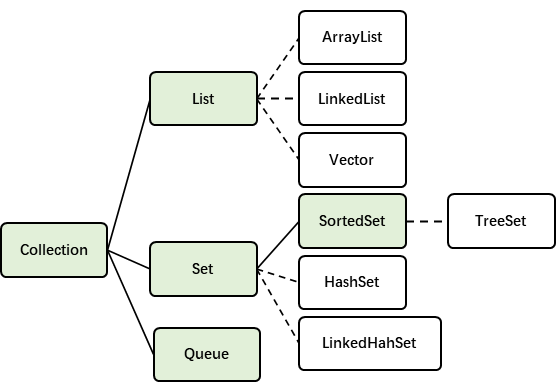*本文是最近学习到的知识的记录以及分享,算不上原创。
*参考文献见文末。
这篇文章主要讲的是java的Collection接口派生的两个子接口List和Set。
目录
Collection框架
List接口
Set接口
1.Collection框架
首先我们综合性地看一下java的Collection接口的框架,如下图:

*图中绿色表示接口,白色表示类。
List接口和Set接口是Collection接口派生的主要的两个子接口。
2.List接口
List的主要特征
(1)有序(ordered):元素的存取是有序的,保证了取出的元素的顺序与输入的元素顺序保持一致。
例如:

1 import java.util.ArrayList; 2 import java.util.LinkedList; 3 import java.util.Vector; 4 5 public class CollectionDemo { 6 public static void main(String[] args) { 7 //ArrayList 8 ArrayList<String> list=new ArrayList<String>(); 9 list.add("11"); 10 list.add("22"); 11 list.add("33"); 12 for(int i=0;i<list.size();++i){ 13 System.out.print(list.get(i)+" "); //output: 11 22 33 14 } 15 System.out.println(""); 16 //LinkedList 17 LinkedList<String> list2=new LinkedList<String>(); 18 list2.add("11"); 19 list2.add("22"); 20 list2.add("33"); 21 for(int i=0;i<list2.size();++i){ 22 System.out.print(list.get(i)+" "); //output: 11 22 33 23 } 24 System.out.println(""); 25 //Vector 26 Vector<String> list3=new Vector<String>(); 27 list3.add("11"); 28 list3.add("22"); 29 list3.add("33"); 30 for(int i=0;i<list3.size();++i){ 31 System.out.print(list.get(i)+" "); //output: 11 22 33 32 } 33 System.out.println(""); 34 } 35 }
(2)索引(index):允许用户根据索引对元素进行精准定位并进行查询、插入、删除等操作。
*所以,对List的遍历,不仅可以通过Iterator,还可以通过索引(index)。
(3)允许重复:允许多个重复的元素存在。
List的主要方法
https://docs.oracle.com/javase/7/docs/api/java/util/List.html
在提到List接口的各种实现类之前,首先我们回顾一下数据结构中数组和链表的各自的特色。
数组易于对元素的查询、遍历,但对元素的增删操作比较繁琐;链表能够方便地对元素进行增删,但不利于元素的查询、遍历。
2.1 ArrayList
http://www.cnblogs.com/skywang12345/p/3308556.html
ArrayList元素存储的数据结构是数组结构。ArrayList相当于动态数组,既保持了数组查询快速的优点,又不像数组那样对元素的增删慢,所以是最常用的集合。
ArrayList的Clone()
ArrayList的clone()属于浅拷贝。
浅拷贝与深拷贝的问题,这与引用对象的存储方式有关系。浅拷贝简单地说,就是把复制一个指向该对象的箭头给你,深拷贝简单地说,就是复制一个对象给你。

当ArrayList中的元素为基本数据类型时,可以说不存在浅拷贝与深拷贝的问题。
例如:

import java.util.ArrayList; public class ListDemo3 { public static void main(String[] args) { ArrayList<Integer> a1=new ArrayList<Integer>(); a1.add(1); a1.add(2); a1.add(3); //基本数据类型: byte short int long float double boolean char ArrayList<Integer> a2=(ArrayList<Integer>) a1.clone(); System.out.println(a1); //[1, 2, 3] System.out.println(a2); //[1, 2, 3] a1.set(0, 10); a2.remove(2); System.out.println(a1); //[10, 2, 3] System.out.println(a2); //[1, 2] } }
当ArrayList中的元素为引用数据类型时,要意识到浅拷贝与深拷贝的问题。
例如:
import java.util.ArrayList; public class ListDemo3 { public static void main(String[] args) { ArrayList<Student> b1=new ArrayList<Student>(); Student s1=new Student(001,"zhangsan",22); Student s2=new Student(002,"lisi",21); Student s3=new Student(003,"wangwu",18); b1.add(s1); b1.add(s2); b1.add(s3); //基本数据类型: byte short int long float double boolean char //引用数据类型:接口interface, 类class, 数组 ArrayList<Student> b2=(ArrayList<Student>) b1.clone(); System.out.println(b1); System.out.println(b2); /* * [Student [id=1, name=zhangsan, age=22], Student [id=2, name=lisi, age=21], Student [id=3, name=wangwu, age=18]] * [Student [id=1, name=zhangsan, age=22], Student [id=2, name=lisi, age=21], Student [id=3, name=wangwu, age=18]] */ b2.remove(2); System.out.println(b1); System.out.println(b2); /* * [Student [id=1, name=zhangsan, age=22], Student [id=2, name=lisi, age=21], Student [id=3, name=wangwu, age=18]] * [Student [id=1, name=zhangsan, age=22], Student [id=2, name=lisi, age=21]] */ b1.get(0).setName("wangmazi"); System.out.println(b1); System.out.println(b2); /* * [Student [id=1, name=wangmazi, age=22], Student [id=2, name=lisi, age=21], Student [id=3, name=wangwu, age=18]] * [Student [id=1, name=wangmazi, age=22], Student [id=2, name=lisi, age=21]] */ } }
第一步:创建ArrayList对象b1

第二步:clone()
从下图中,可以看到左边的箭头和右边的箭头,箭头左边是地址,箭头右边是指向的对象。我们可以发现虽然b1和b2的地址不同,但指向相同的对象。如果仅仅改变左边的箭头,如改变b1的箭头则不会影响到b2,但如果改变了右边的箭头,如改变了s1的箭头,就会同时对b1, b2造成影响。

Arraylist的遍历
ArrayList有三种遍历方式。
例如:
import java.util.ArrayList; import java.util.Iterator; public class ListDemo2 { public static void main(String[] args) { ArrayList<String> list=new ArrayList<String>(); list.add("11"); list.add("22"); list.add("33"); //第一种遍历方式:Iterator Iterator<String> it=list.iterator(); while(it.hasNext()){ System.out.print(it.next()+" "); //11 22 33 } System.out.println(""); //第二种遍历方式 for(int i=0;i<list.size();++i){ System.out.print(list.get(i)+" "); //11 22 33 } System.out.println(""); //第三种遍历方式 for(String s:list){ System.out.print(s+" "); //11 22 33 } System.out.println(""); } }
结果显示,这三种遍历方法中,第二种(使用索引index)的效率最高,第一种(使用Iterator)的效率最低。
ArrayList的toArray(T[] contents)
Arraylist提供了两个将ArrayList转换为数组的方法:
Object[] toArray()
<T> T[] toArray(T[] contents)
由于toArray()返回的类型是Object[],如果进行强制类型转换会造成java.lang.ClassCastException。因此调用toArray()容易出错,更建议使用toArray(T[] contents)。
例如:
import java.util.ArrayList; import java.util.Arrays; public class ListDemo2 { public static void main(String[] args) { ArrayList<String> list=new ArrayList<String>(); list.add("11"); list.add("22"); list.add("33"); //方法1 String[] str=new String[list.size()]; str=list.toArray(str); System.out.println(Arrays.toString(str)); //[11, 22, 33] //方法2 String[] str2=(String[])list.toArray(new String[0]); System.out.println(Arrays.toString(str2)); //[11, 22, 33] } }
2.2 LinkedList
LinkedList元素存储的数据结构是链表结构。LinkedList能够方便地对元素进行增删。
LinkedList提供了一些方法,来方便对首尾元素的操作。
LinkedList还可以作为堆栈、队列的结构使用,所以提供了一些和堆栈、队列相关的方法。
例如:

1 import java.util.LinkedList; 2 public class ListDemo1 { 3 public static void main(String[] args) { 4 LinkedList<String> list=new LinkedList<String>(); 5 list.add("11"); 6 list.add("22"); 7 list.add("33"); 8 while(!list.isEmpty()){ 9 System.out.print(list.pop()+" "); //output: 11 22 33 10 } 11 System.out.println(""); 12 } 13 }
*注意元素存取的顺序,保持着先进先出的顺序。
2.3 Vector
Vector元素存储的数据结构是数组结构。Vector与ArrayList类似,Vector提供的Enumeration与ArrayList提供的Iterator类似,二者在功能上可以说的上是重复的。
例如:

1 import java.util.ArrayList; 2 import java.util.Enumeration; 3 import java.util.Iterator; 4 import java.util.Vector; 5 6 public class ListDemo1 { 7 public static void main(String[] args) { 8 //ArrayList和Iterator 9 ArrayList<String> list=new ArrayList<String>(); 10 list.add("11"); 11 list.add("22"); 12 list.add("33"); 13 Iterator<String> it=list.iterator(); 14 while(it.hasNext()){ 15 System.out.print(it.next()+" "); 16 } 17 System.out.println(""); 18 //Vector和Enumeration 19 Vector<String> list2=new Vector<String>(); 20 list2.add("11"); 21 list2.add("22"); 22 list2.add("33"); 23 Enumeration<String> en=list2.elements(); 24 while(en.hasMoreElements()){ 25 System.out.print(en.nextElement()+" "); 26 } 27 System.out.println(""); 28 } 29 }
3.Set接口
Set的主要特征
(1)不允许重复:元素不允许重复。Set在存储元素时会通过hashCode()和equals()来保证元素的唯一性。
Set如何保证元素的唯一性
Set在存储元素时,通过hashCode()和equals()来保证元素的唯一性。
事实上,当存储一个新的元素时,仅仅通过equals()来逐一判断新元素是否与集合中已有的元素是否重合,这种方法也是可行的,那为什么还需要hashCode()呢。因为当Set中元素数量很多时,通过equals()逐一判断并不是一个高效率的方法,所以同时通过hashCode()和equals()进行判断可以提高判断的效率。
首先,我们回忆一下什么是hashcode。
https://www.cnblogs.com/dolphin0520/p/3681042.html
hashCode()是Object的类,每个对象都具有hashCode值。不同的对象可能会有相同的hashCode值,但hashCode值不相同的两个对象肯定不同。
我们可以用映射的概念来理解对象与hashCode之间的关系,对象(value)与hashCode(key)构成了多对一的映射。
当每次存储新的元素时,首先通过hashCode()获得新元素的hashCode,判断是否与已有元素的hashCode相同。如果没有,将新元素加入到集合中。如果有,再通过equals()判断元素是否相同,如果相同,则不添加该元素,如果不同,则把该元素加到集合中。
3.1 HashSet
HashSet元素存储的结构是哈希表。
hashSet除了不允许重复元素外,还不能保证元素存取的顺序。
例如:

1 import java.util.HashSet; 2 import java.util.Iterator; 3 4 public class setDemo1 { 5 public static void main(String[] args) { 6 HashSet<String> hash=new HashSet<String>(); 7 hash.add("11"); 8 hash.add("22"); 9 hash.add("33"); 10 Iterator<String> it=hash.iterator(); 11 while(it.hasNext()){ 12 System.out.print(it.next()+" "); 13 } 14 System.out.println(""); //output: 22 33 11 15 } 16 }
hashCode()和equals()的重写
就像我们刚才提到的,hashSet是通过hashCode()和equals()来保证元素的唯一性。JaveAPI中的每个类(如String, Integer类)都能获得hashCode和equals的比较方法,所以这类元素可以直接用hashSet存储,但是用户自定义的类,也需要先重写hashCode()和equals(),之后才能用hashSet存储该类元素。
*Object的equals()与==功能相同,判断的是地址是否相同。所以想要判断内容是否相同,必须要重写equals(),比如String类。
例如:

//用户自定义类 public class Student { private int id; private String name; private int age; //构造方法 public Student() { // TODO Auto-generated constructor stub } public Student(int id,String name,int age){ this.id=id; this.name=name; this.age=age; } //getter and setter public int getId() { return id; } public void setId(int id) { this.id = id; } public String getName() { return name; } public void setName(String name) { this.name = name; } public int getAge() { return age; } public void setAge(int age) { this.age = age; } //overwrite hashCode() and equals() @Override public int hashCode() { final int prime = 31; int result = 1; result = prime * result + age; result = prime * result + id; result = prime * result + ((name == null) ? 0 : name.hashCode()); return result; } @Override public boolean equals(Object obj) { if (this == obj) return true; if (obj == null) return false; if (getClass() != obj.getClass()) return false; Student other = (Student) obj; if (age != other.age) return false; if (id != other.id) return false; if (name == null) { if (other.name != null) return false; } else if (!name.equals(other.name)) return false; return true; } //overwrite toString() @Override public String toString() { return "Student [id=" + id + ", name=" + name + ", age=" + age + "]"; } } //hashSet分别存储JavaAPI类和用户自定义类 import java.util.HashSet; import java.util.Iterator; public class setDemo1 { public static void main(String[] args) { //用HashSet存储JavaAPI类,如String、Integer等 HashSet<String> hash=new HashSet<String>(); hash.add("11"); hash.add("22"); hash.add("33"); hash.add("22"); Iterator<String> it=hash.iterator(); while(it.hasNext()){ System.out.print(it.next()+" "); } /* * 不允许重复元素 * 不保证存取顺序 */ System.out.println(""); //output: 22 33 11 //用HashSet存储用户自定义类 //首先在用户自定义类中需要重写hashCode()和equals() HashSet<Student> hash2=new HashSet<Student>(); Student s1=new Student(001,"zhangsan",22); Student s2=new Student(002,"lisi",21); Student s3=new Student(003,"wangwu",18); hash2.add(s1); hash2.add(s2); hash2.add(s3); hash2.add(s1); Iterator<Student> it2=hash2.iterator(); while(it2.hasNext()){ System.out.println(it2.next()+" "); } /* * output: * Student [id=3, name=wangwu, age=18] * Student [id=1, name=zhangsan, age=22] * Student [id=2, name=lisi, age=21] */ } }
3.2 LinkedHashSet
LinkedHashSet的元素的存储结构是链表和哈希表。
LinkedHashSet保证了元素存取的顺序。
*LinkedHashSet遵循先进先出的顺序
例如:

1 import java.util.Iterator; 2 import java.util.LinkedHashSet; 3 4 public class setDemo2 { 5 public static void main(String[] args) { 6 LinkedHashSet<String> lset=new LinkedHashSet<String>(); 7 lset.add("11"); 8 lset.add("22"); 9 lset.add("33"); 10 Iterator<String> it=lset.iterator(); 11 while(it.hasNext()){ 12 System.out.print(it.next()+" "); 13 } 14 System.out.println(""); //output: 11 22 33 15 } 16 }
3.3 TreeSet
TreeSet可以保证元素存取的顺序。
参考文献
https://docs.oracle.com/javase/7/docs/api/java/util/List.html
